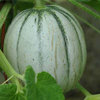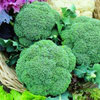Melon F1 Irina is probably the easiest melon to grow in our climate. It is more tolerant of lower temperatures than most varieties and one of the quickest to mature.
With smooth, grey-green skin and sweet aromatic and light orange flesh, the melons are typically the size of large grapefruits, about 11.5cm (4½in) in diameter and weight about 600 grams (1½lbs). When ripe they have a wonderfully complex and full bodied flowery aroma and a sophisticated flavour.
F1 Irina has been awarded the RHS Award of Garden Merit and has been trialed, tested and is recommended by the National Institute of Agricultural Botany. It is suitable for growing in frames or under cloches and is recommended for northern districts.
Irina is a Charentais type of melon, (pronounced sha-rahn-tay) that is native to France. They are considered by many to be the most divine and flavorful melons in the world. Charentais are small with ridged, sage-colored skin and dense, perfumed orange flesh, and they are a member of the cantaloupe family. Popular in Europe, Charentais' are especially prized in France for their rich, honeyed finish. Try wrapping slices of Charentais with prosciutto as an appetizer or cut one in half and serve with port wine poured over it for a special dessert.
You won't find Charentais in your grocery store - its thin skin and high sugar content make it fragile to ship when ripe. Nothing beats the flavour of a ripe, juicy melon eaten straight from the greenhouse on a summer afternoon - surely one of the sweetest rewards of home gardening.
Awarded the RHS Award of Garden Merit.
Recommended by the National Institute of Agricultural Botany.
Sowing: Sow from March to the end of May
Melon seeds are sown from late winter to spring in hotter countries, but in our temperate zone sow indoors from March to the end of May. Sow 1cm (½in) deep directly into 8 to 10cm (3 to 4in) pots using standard free draining potting compost. Keep moist at all time. Seeds will germinate at temperatures above 21°C (68°F). Germination usually takes 6 to 10 days at 24°C (75°F).
Transplant when large enough to handle into 13cm (5in) pots. Grow on in good light at around 15 to 18°C (59 to 64) before planting 75 to 100cm (30 to 39in) apart when all risk of frost has passed. Planting into an unheated glasshouse or polytunnel must not take place until the compost or soil is sufficiently warm (18°C / 64°F ) and the air temperature likewise. Set the plants out firmly but do not compact the soil.
The planting area must be adjacent to suitable support if the melons are to be trained in conventional fashion. When planting, you may wish inserting a 7cm (3in) pipe into the soil so you can water directly to the roots with a watering can.
Top dress with good compost when white roots are seen. If the basal leaves begin to yellow feed with a liquid tomato fertilizer. Feed weekly once the fruits begin to form.
Training:
Melons can be trained up a simple single line of string tied to the supports in the glasshouse roof and secured in the ground with a peg next to the base of the melon or use a fan trellis which is simple and reusable next season.
As the melon starts to grow, tie the strongest shoot to the support and pinch out the side shoots which grow from the main stem. As the plants grow pinch out each stem a couple of leaves beyond the female flowers.
Once the stem has reached the top of the support pinch out the leading shoot. This will make the plant concentrate on the formation of fruits. Sprawling plants are simply left to develop and restricted to avoid growth congestion as required.
Watering:
Watering holds the key to successful melon growing. Regular watering is essential, try to keep the compost constantly moist but not wet. You need to water so that the plant never gets wet, avoid sogginess around the plant stem as this can cause stem rot. Over watering can cause the fruit to split. Possibly the best way to water is with a drip irrigation system.
Glasshouse conditions in high summer need to be kept humid on the hottest days by watering the path early in the morning or by standing a bucket of water in the glasshouse.
Melons need sufficient moisture while growing and fruiting, but prior to harvest, the best, sweetest flavour will occur if the plant is grown on the "dry" side. Cut back on watering the plant when you approach harvest, about three weeks prior to the main crop harvest.
Pollination:
Once the flowers have formed, you will need to pollinate the flowers. This is best carried out mid day when the humidity is high. Females have a swollen part at the base of the bloom. Either remove a male flower and place it inside a female bloom, or take a small paintbrush and lightly brush each flower in turn to. After 2 or 3 days remove the male flowers from the plants.
Support:
As soon as the fruits reach the size of tennis balls you need to use string nets or other means to support them. For sprawling plants, a layer of straw should be put down to prevent fruit damage. As the summer progresses and the fruits reach full size remove a few leaves to allow the fruit to ripen.
Harvest: July to August.
Judging when melons are ready to harvest IS an exact science ? don?t be told otherwise. Whether it is late in the garden or early in a greenhouse, the plants will tell you when to pick. In the case of the muskmelons (cantaloupe and honeydew), the short stem seems to become backed up with juice, as though the fruit can take no more. It becomes soft to the point that if you give it a slight pinch, the fruit will fall off. Some fruits may actually fall off the vine, so keep a careful eye on each one as it develops.
Many mature cantaloupes are orangey yellow on the outside, beneath all that netting. They are not green. The ones you find in the store are nearly always unripe. They have to be unripe in order to ship them to you. Eating cantaloupe at ideal ripeness is a nuanced dance ? a complex perfection of textures, flavour, and sweetness.
The terminology for picking cantaloupe at full maturity is "full slip", this means that the "belly button" at the top of the melon will be clean of any signs of the vine having been ripped off during harvest. If the belly button has pieces of the vine still attached, even a small piece, this melon will NEVER ripen.
The best test of course is smelling the melon, look for melons where the outside rind is turning from green to yellow a sign of the ripening process and smell it. The cantaloupe should smell sweet and have a fantastic aroma as if you had just taken a knife and cut it open. No smell means it's not ripe, but if the belly button is clean, then it will of course ripen in time.
Also, the belly button should be dry, if you gently push with your thumb the flesh should not come away and no sign of mold should be present. It's okay if the melon is a little soft to touch as long as it's ripe. The same applies to Galia and Musk melons except that the outside rind must always be firm to touch.
Watermelon vines have many more tendrils than cantaloupes, and there is always a tendril very close to, but opposite, the stem to each fruit. When this tendril dries completely and turns from green to brown, the fruit nearest it is ripe. Without fail, this is true.
To speedup the ripening process place the melon in a plastic bag and seal the bag with a twist tie and place on your kitchen counter. This traps the natural ethylene gas cantaloupes produce inside the bag and the melon will ripen in a couple of days. Remove the bag after the cantaloupe has ripened and refrigerate until you're ready to eat it.














 Doff Hormone Plant & Cuttings Rooting Powder 75g
Doff Hormone Plant & Cuttings Rooting Powder 75g




